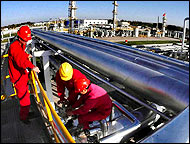
People suffering from acute energy shortages in the northern Beijing-Tianjin-Hebei region are about to benefit from the giant West-East Gas Pipeline project, which is expected now to serve well beyond its original limits.
PetroChina, the nation's largest oil and gas producer, plans to invest some 7.7 billion yuan (US$931 million) on improving the pipeline's gas supply capacity within the year.
The cash will be used to link the main line with the second Shaanxi-Beijing pipeline that should supply natural gas from Shaanxi Province in the northwest to the capital from next month, as well as to build one gas storage tank in Jiangsu Province and six gas pumping stations at the western end.
Upon completion by year-end, the 4,200-kilometre pipeline will supply 12 billion cubic metres of natural gas a year, two years earlier than planned, sources from PetroChina said.
Another part of the plan is the Jining linkage line between the main West-East pipeline and the second Shaanxi-Beijing pipeline, that will be completed by the end of the year and start operations in January.
Spanning the three provinces of Jiangsu, Shandong and Hebei, the linkage line extends 890 kilometres and is China's first digitalized transport pipeline based on as many as eight digital-control technologies such as satellite remote control, geographical information systems and a large database technology, according to PetroChina.
"The Jining linkage line is an energy artery that runs through East China, North China, the Bohai-rim region and the Yangtze River Delta - another major gas pipeline in China to follow the West-East Gas Pipeline and the second Shaanxi-Beijing gas pipeline," a PetroChina official said.
"As a back-up line of the West-East project, the linkage line cannot only co-ordinate gas supplies from the two major pipelines in the north and south to serve consumers along its range, but also, and more importantly, is able to diversify the energy supply mix in the country's two major economic converges of the Yangtze River Delta and the Bohai-rim region."
Tapping new sources
To secure a gas supply to the highly energy-dependent capital city, Beijing has made strenuous efforts to lock in new sources of natural gas to fuel the fast-expanding economy, which felt the pinch from gas shortages last winter when demand peaked.
Liu Yinchun, an official from the Beijing Municipal Development and Reform Commission in charge of infrastructure construction, earlier last month said the capital city will boast three gas sources by 2010.
Construction of the second Shaanxi-Beijing gas pipeline is expected to wrap up by the end of July and with the first Shaanxi-Beijing line, with an annual gas supply capacity of 3.3 billion cubic metres, the two lines will transport at least 15 billion cubic metres of gas from fields in Shaanxi Province to the northern part, centring on Beijing.
The country's top policy planner, the National Development and Reform Commission (NDRC), has also given permission to PetroChina to build a liquefied natural gas (LNG) terminal in the Caofeidian port of Tangshan in Hebei Province to import natural gas on soaring demand in the Beijing-Tianjin-Hebei region, Su Shulin, senior vice-president of the nation's largest oil and gas producer, said.
The project, designed to handle 3 million tons of LNG in the first phase, is scheduled to start construction within the year and begin operations by 2010 at the latest, sources close to the project said.
In addition, the under-construction Jining linkage line will secure a further source for gas supply to the robust regional economy in northern areas. Industry experts said it is a strategic and far-sighted point of view for China to diversify energy supplies for long-term economic security.
"It is a wise way for a city to rely on both in-land gas pipelines and LNG imports for its gas supplies," said Zhang Kang, a senior analyst with a research institute under Sinopec, Asia's largest oil refiner and China's second-largest oil & gas producer after PetroChina.
Guy F Caruso, administrator of the Energy Information Administration under the US Department of Energy, earlier this month said that China's consumption of natural gas is expected to see the fastest growth within coming years because of its cleanness and more immediate availability.
Beijing used 2.7 billion cubic metres last year, up 700 million cubic metres from 2003, compared with an annual increase of some 300-400 million in the previous year, official statistics show.
The city's demand is projected to double to 5 billion cubic metres by 2008 as it switches away from gas made from coal in its drive to cut pollution in time for the Olympics.
Shanghai, another big consumer in China, will expect an LNG terminal to import as much as 6 million tons of LNG a year by 2008, to supplement the gas transported through the West-East pipeline, as China National Offshore Oil Corp (CNOOC), the country's third largest oil and gas producer, starts the LNG project there.
As well as the capital city, the beneficiaries of the Jining linkage gas line include residents in Jiangsu, Shandong and Hebei provinces.
The linkage line, for example, has 380 kilometres running through Shandong Province, and at least 70 per cent of the infrastructure has been completed.
The province's fast-growing economy has fuelled rising demand for energy, which has relied an overwhelming 70 per cent on coal. Natural gas currently only accounts for 2 per cent of the total energy mix, according to sources from the local government.
The eastern province can only lock in 500 million cubic metres of natural gas per annum, but its demand stands at 1.5 billion cubic metres a year.
Access to more gas supplies will play a fundamental role in optimizing the province's energy resources, as well as in increasing its energy-using efficiency and sustainably driving the local economy, the official said.
(China Daily June 22, 2005)
|

